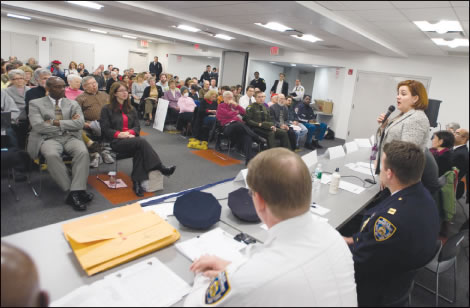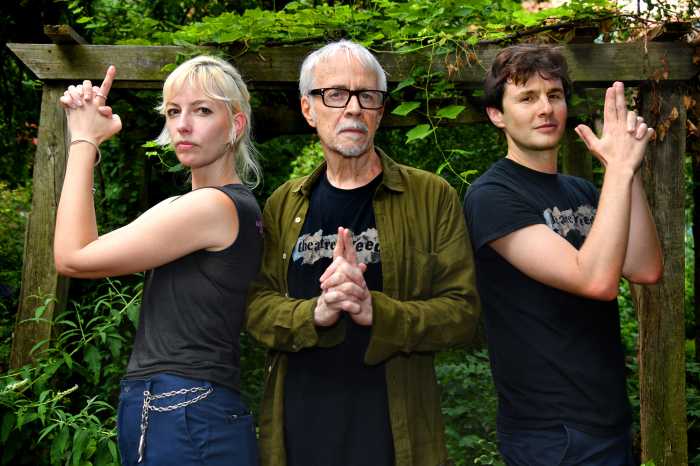By Diane Vacca
Everyone thinks they have a handle on the issue of tour bus traffic on the West Side.
Change the routes, critics say, and simply send them to other neighborhoods. Get the buses off 42nd St. and park them on 41st St. Silence tour bus loudspeakers by giving passengers headsets, and convert the coaches to nonpolluting, Prius-like hybrids. And issue tickets, and then more tickets.
At a town hall meeting on Thurs., Nov. 12, at the Hudson Guild on W. 26th St., more than 100 West Siders joined City Council Speaker Christine Quinn, elected officials and representatives of city and state agencies to air their complaints and seek solutions to the problems posed by tour and charter buses.
Manhattan lured nearly 50 million tourists last year, according to city statistics, but remains in the throes of an unhappy love affair with the coaches carrying many visitors. In Hell’s Kitchen, the Lincoln Tunnel disgorges 6,000 commuter, long-distance and tour buses into Manhattan every day.
The upside is that with about 50 passengers, a single bus replaces as many as 50 cars. While tourists are filling the coffers of the city and its merchants, the buses that bring them are condemned to snake along the avenues and streets, looking for a temporary parking place — the elusive legal layover.
“We [can’t] put [the layovers] in front of any residential building… . We also can’t really put them in front of commercial buildings and retail,” explained Margaret Forgione, Manhattan borough commissioner of the city’s Department of Transportation. “We can’t place them on Fifth Ave., we can’t place them in Midtown Manhattan, we can’t place them in Downtown Manhattan.”
Clearly, the buses have to go somewhere, since stretches like 10th Ave. between 33rd and 40th Sts. are lined with coaches, said Deputy Inspector Michael Pilecki, of the Police Department’s Parking Enforcement division.
No funds for bus garage
“I have no good news,” Quinn said in respect to a proposed bus garage on the West Side, a solution many regard as ideal. The Port Authority no longer has the money for “the long-promised, ever-maybe” garage, she said, and it has been dropped from the city’s budget as well. Still, Quinn said, “The answer isn’t to plug up the tunnel and have nobody come in.”
At least 300 long-distance buses park in Hell’s Kitchen every day, occupying about 2.6 miles of curb space, said Christine Berthet, co-chairperson of Community Board 4’s Transportation Committee. The buses park in front of schools and in spaces reserved for transportation for the disabled, added Walter Mankoff, a Penn South resident and a member of Board 4’s Transportation Committee.
The coaches also pull into stops designated for the M.T.A., as on Seventh Ave. between 41st and 42nd Sts., where there is a stop for four M.T.A. buses.
“We, the people who ride the M.T.A., we have to to jump out to the second lane and sometimes the third lane,” said Karlene Weiss. “We also have to stand, between two — or three — tour buses, waving our MetroCards.”
Though forbidden by law to idle their engines for more than three minutes, or one minute near a school, bus drivers are hesitant to abide by the rules to avoid being ticketed for illegal parking. Instead of shutting off their engines, drivers are ready to move on at a moment’s notice when a traffic enforcement agent comes into view. Additionally, idling is permitted while the bus is loading or unloading passengers, a process that can take 10 minutes.
But idling comes at a steep cost, according to community advocates.
“The West Side has one of the highest rates of childhood asthma in the city,” said Jackie Del Valle, director of organizing for the Hell’s Kitchen-based Housing Conservation Coordinators, which started a campaign this summer to encourage drivers to stop idling near schools.
In Chelsea, tour buses park in spots designated for M.T.A. buses on Seventh Ave. between 26th and 28th Sts., reported Lisa Wager, director of government and community relations for the Fashion Institute of Technology. The idling coaches’ passengers and their luggage create congestion on the street, and they dump their garbage into nearby trash cans, causing them to overflow.
Martin Whelan, who owns Stout restaurant and bar on 33rd St. between Sixth and Seventh Aves., said long-distance buses present a different problem. They line up on 33rd St., which is “a funnel for people going to Penn Station,” he noted. “D.O.T. will give me a $100 ticket for having a chalkboard out on the sidewalk, but you walk down 100 yards, and there’s 40 people with 40 suitcases, legally.”
To that end, Whelan offered a simple solution: “Move that stop two blocks — there’s no commercial business between Eighth and Ninth Aves. on 33rd St.”
Another Chelsea resident, Mark Davis, claimed that out-of-service city buses both park and double-park in front of fire hydrants and in no-parking zones on 23rd St. between Fifth and Eighth Aves., and especially between Sixth and Seventh Aves., where they double-park on both sides of the street. But the police never disturb them, he noted.
“I just want to know how we are, as a city, supposed to set an example for the tour bus companies,” he asked, “because we can’t get anybody to do anything about our own laws.” Davis added, “I didn’t want to say anything because of all the police with guns here, but they say they don’t do it [enforce rules against buses] as a courtesy.”
Quinn replied quickly, “That courtesy may be coming to an end.”
In the West Village, residents object most vehemently to the buses when they are actually filled with tourists. Village streets were never intended for the large buses that “lumber through…like giant elephants following one another,” observed Judy Makida. She said narrow Bleecker St., which has a bike lane and parking on both sides, sees about 150 buses “whiz” through daily. The buses have difficulty turning, and the traffic backs up as a result, she said. They also don’t stop to let passengers off, so Bleecker St. merchants can’t benefit from the tourist dollars, Makida added. Residents also complain that tourists on double-decker buses can peer into their windows as they roll by, and the amplified voices of the tour guides resound to the dismay of the neighbors on the street.
As in Chelsea and Hell’s Kitchen, buses in the Village block traffic when they double-park, offload or take on passengers, residents complained.
Trying to regulate stops
However, Forgione said, “In New York City, any vehicle, including a bus, can pull over at any curbside and expeditiously load and unload.” D.O.T. is working with the state to craft legislation that would prohibit buses traveling in the city from stopping wherever they like. Under the proposed law, buses would have to register with the department and obtain officially approved stops in order to operate.
Deputy Inspector Pilecki added that commercial vehicles are permitted to double-park outside the Midtown core — defined as between 14th and 60th Sts., from First to Eighth Aves. — “provided there’s no space within 100 feet on either side of the street.” Nevertheless, he didn’t know whether a double-parked bus qualifies for that exception.
“If it is a legal loophole, we’ll figure out a way to close it,” Quinn responded.
Village residents of narrow streets like Bleecker and Hudson Sts. beseeched D.O.T. to reroute the tour buses in their neighborhood. Judith Chazen Walsh, a Bleecker St. resident, believes it is “reasonable” for D.O.T. to regulate bus routes, as traffic agencies do in cities like Boston, Philadelphia and Washington, D.C. The lawyers for her neighborhood group — Buses Off Bleecker, a.k.a. BOB — say D.O.T.’s mission to move pedestrians and traffic effectively and safely also gives it the right to regulate routes.
Forgione acknowledged that Bleecker St. has been a problem for years.
Nevertheless, she said, “We cannot prohibit the buses from using Bleecker St. What we can do at D.O.T. is tell them where they can have a bus stop and where they can’t.”
Quinn disagreed, saying the department’s authority to establish tour-bus routes is “the legal discussion we’re having right now. Some lawyers on the City Council believe that,” she said. “I’m pushing to look at it in other ways that would give us more authority.”
As for amplified sound, Quinn said there is legislation pending in the Council that would require tourists on the buses to wear headsets so that “if you were in your living room, you wouldn’t get the tour information also.”
Suffice it to say, bus drivers and West Siders are having a very hard time being friends.
Hardy Phippen, who is both a local resident and a tour guide, made the case for tourism. It is a growth industry in New York City as baby boomers retire, he said, adding that the economic recovery is also bound to bring more tourists.
‘Think of the bus drivers’
“The situation today is unsatisfactory and unsustainable, both for our local communities and for the tourists and their coaches,” Phippen said. “I feel for the coach drivers coming into Manhattan. There are few places to park, and those existing are hard to discover, inadequate and inconvenient. Drivers are forced to cruise around [with] empty [buses], over crowded streets, adding to congestion and pollution. With nowhere to park for a break, they become tired and stressed, a safety issue. If they do pull over to wait, all that is usually available is an illegal space.
“For coach drivers in Manhattan,” Phippen continued, “their coach is their private and movable prison cell. What crime have they committed? They brought tourists here, which everyone agrees benefits our economy.”
Quinn pledged to gather residents, merchants, tour guides and bus companies around the negotiating table. She is in talks with D.O.T. and the state Department of Environmental Conservation to create an inter-agency task force on bus idling that would meet monthly or bimonthly. Despite legal thickets, since it’s not clear what legislative power belongs to the city, D.O.T. is trying to obtain changes from the state regarding drop-off and pickup sites. Quinn added she would like to see a holiday ticketing blitz for idling buses.
Deputy Inspector Pilecki repeatedly asked for specifics throughout the meeting whenever he heard a complaint, noting that Parking Enforcement deploys its resources based on complaints.
“So if we can get information based on the particular locations, that you’re having a problem,” he said, “we’d be more than happy to send out our traffic agents to these particular areas to address them.”
Unlike Parking Enforcement, which has 3,000 agents throughout the city, the Department of Environmental Conservation has only 18 officers for the New York City area, said D.E.C. spokesperson Arturo Garcia-Costas. Consequently, the department needs specific information about idling hot spots to make the most effective use of scarce resources.































